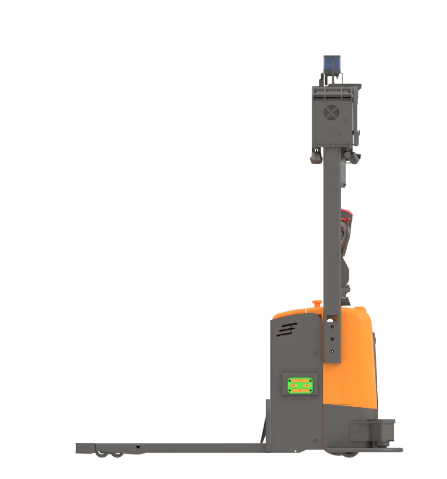How Autonomous Forklift Robots Slash Labor Costs
Reducing Dependency on Human Operators
Self-driving forklifts are making companies less dependent on human workers, which takes a big weight off the shoulders of managers dealing with staff issues. When businesses bring in this tech, they save money on wages and stop worrying so much about creating schedules or handling employee problems. Some companies report cutting their warehouse staff numbers by around 30% after switching to automated systems. The savings go beyond just payroll too. These robots handle repetitive tasks day in and day out without needing breaks or benefits packages, so overall running costs come down quite a bit. Many logistics managers find this shift worth the investment despite the upfront expenses.
24/7 Operation Capabilities
What really sets autonomous forklifts apart is how they keep going nonstop day after day. Human drivers need rest periods, but these robotic machines just keep working without pause, which means operations never stall. The fact that they run 24 hours a day seven days a week has been shown to boost productivity quite dramatically in some warehouses. Some research suggests productivity might actually jump by as much as half in certain situations. For companies dealing with high volume or tight deadlines, this kind of continuous operation makes all the difference when trying to meet those demanding production targets during busy seasons.
Lower Workforce Turnover Expenses
When companies bring in autonomous forklift robots, they tend to see lower costs from staff turnover as well. Less need for human workers means saving money on all those hiring processes, training sessions, and keeping employees happy programs that get really expensive when the job market is shaky. Some businesses actually report around 20% savings on personnel costs after switching to automated systems. These kinds of savings help operations stay steady even during tough times, and cut down on the unpredictable spending that comes with fluctuating workforce needs in manufacturing environments.
Boosting Efficiency with Automated Material Handling
Minimizing Human Error in Inventory Management
The shift to automated systems cuts down on those pesky human mistakes that plague inventory management when done manually. Autonomous forklifts equipped with smart algorithms and sensor tech keep track of what's actually on the shelves versus what the system says should be there. The result? Much more accurate stock counts that businesses can actually trust. These kinds of improvements matter because nobody wants to deal with missing products or overstock situations that eat into profits. According to industry data, warehouses that go fully autonomous see error rates drop around 90% compared to traditional methods. While no system is perfect, this kind of accuracy makes a huge difference in day-to-day operations and bottom line results for most companies.
Optimized Route Planning for Faster Workflows
Autonomous forklifts are pretty good at figuring out the best routes around facilities, thanks to their smart software that constantly adjusts based on what's happening on the floor. When these machines plan out their paths efficiently, they get jobs done faster while keeping traffic jams at bay in places like warehouse floors and shipping hubs. Some companies report seeing workflow boosts around 40% after implementing better routing strategies, according to recent industry reports. What makes all this work so well is how these systems actually reduce those pesky bottlenecks that slow everything down, which means more goods moved, fewer delays, and ultimately higher productivity across operations.
Seamless Integration with Warehouse Management Systems
Bringing autonomous forklifts into line with current warehouse management systems (WMS) makes good business sense for most operations. When these machines work together with the software, they track inventory much better and handle restocking tasks automatically instead of relying on workers to do everything manually. The forklifts talk constantly with the WMS platform, giving managers fresh data about what's in stock, where things are moving around the facility, and when new items need to come in. Warehouse managers report seeing around a 25-30% boost in overall efficiency after implementing this kind of system integration. For facilities looking to stay competitive in today's market, getting these technologies to work together smoothly is becoming almost necessary, though many still struggle with the initial setup costs and training required for staff to adapt to the changes.
Safety-Driven Cost Reductions
Collision avoidance systems preventing accidents
Worker safety remains a top priority across industrial settings, which is why many companies now turn to autonomous forklifts fitted with smart collision detection tech. These machines come loaded with laser scanners, radar units, and high-res cameras that spot anything in their path, making warehouse floors much safer places. The benefits go beyond preventing dents and scratches on inventory items. Workers actually feel more secure knowing these robots won't plow through them at full speed. Some factories report cutting accident rates by around 60% after installing this kind of system, though results vary depending on how well they maintain the equipment. From a business standpoint, spending money on these safety features isn't just good ethics. It pays off financially too when looking at all the savings from avoiding medical bills, lost productivity, and insurance claims.
Reduced workplace injury compensation claims
Workplace accidents cost companies way more than just fixing broken equipment or injured workers. They lead to long drawn out compensation processes that drain company budgets. When businesses switch to autonomous forklifts with their fancy safety tech, accident rates drop off a cliff. We've seen this happen across warehouses nationwide actually. The money saved on workers' comp claims? That goes straight to the bottom line. Companies aren't just pocketing cash either they're reinvesting it into other areas of their operations. Real world data shows something pretty impressive too. Warehouses that went fully automated reported around 40% fewer injury claims last year alone. Makes sense why so many logistics managers are pushing for these self-driving machines despite the upfront investment.
Lower insurance premiums through risk mitigation
Fewer accidents at work means lower insurance bills, something many companies turning to automation have noticed recently. Insurers see automated systems as safer options overall, so they tend to offer discounts on premiums when businesses implement these technologies. The savings help cut down operating costs while making it even more attractive for companies to invest in automation solutions. Some studies show insurance costs drop around 20% after automation is put in place, which makes sense when considering both improved worker safety and direct money saved. For manufacturers especially, getting automation right isn't just about avoiding claims though. Many plant managers report seeing better bottom lines across multiple areas once machines take over repetitive tasks that used to cause injuries.
Scalability for Long-Term Savings
Adapting to Peak Demand Without Hiring Surges
Self-driving forklifts give warehouses serious flexibility when they need to ramp up operations during busy seasons without going through the hassle of hiring new workers or spending time on training sessions. The ability to scale quickly means businesses stay ahead of sudden spikes in customer orders while keeping everything running smoothly behind the scenes. Many logistics managers have found that automated equipment lets them handle much higher volumes than traditional setups would allow, all without blowing their budget on extra labor costs. This kind of operational boost gives companies a real edge in industries where speed and responsiveness make all the difference between winning contracts and losing out to competitors.
Gradual Fleet Expansion vs Permanent Labor Costs
Getting a bunch of autonomous forklifts into operation gives companies room to grow at their own pace rather than dealing with all those headaches from hiring extra staff suddenly. Businesses expanding slowly can avoid the chaos that comes with rapid workforce growth while still keeping operations running smoothly. The cost benefits really start adding up over time too. We're talking about real money saved compared to constantly paying wages for human workers. Some actual numbers back this up too businesses adopting robotics as their go-to solution when they need more capacity typically see around a quarter reduction in costs according to industry reports. Makes sense really when looking at how much downtime and training expenses get cut out of the equation.
Predictive Maintenance Reducing Downtime Expenses
Predictive maintenance has become essential for cutting down on equipment downtime and keeping operations running smoothly without hiccups. When companies spot potential problems before they actually happen, they save money on unexpected breakdowns and keep their production lines moving forward. Industry data shows most businesses see around a third reduction in those expensive downtime costs after adopting these proactive approaches. For manufacturers especially, this kind of maintenance isn't just about saving cash either it helps maintain product quality standards too, which matters a lot when customer satisfaction is on the line.
Real-World ROI: Case Studies in Automation
Amazon's 70% Operational Cost Reduction Strategy
By bringing autonomous tech into their warehouses, Amazon managed to cut down operational expenses by around 70%. The way they've rolled out these machines shows just how much automation shakes up traditional warehouse operations. What Amazon is doing here isn't just setting some kind of efficiency standard either. It actually demonstrates that when companies invest in tech solutions, they completely rewrite what their bottom line looks like across different sectors. Other businesses watching this development closely realize something important too many are starting to see that if they follow suit with similar approaches, they'll likely experience significant savings in their day to day running costs as well.
Walmart's Accident-Free Warehouse Implementation
When Walmart started rolling out automated systems across its warehouse operations, they saw some pretty significant improvements both in worker safety and how efficiently things ran day to day. The robots and automated processes have basically eliminated workplace accidents at many facilities, showing that it's possible to make workplaces safer while actually cutting down on expenses at the same time. This approach gives other companies something tangible to consider when thinking about investing more in automation solutions. Looking at what's happening elsewhere in the industry, plenty of businesses are already following suit with their own versions of Walmart's strategy, adapting similar technologies to match their specific needs and seeing results that mirror those early successes.
Asian Manufacturing Hubs Achieving 24-Month Payback Periods
Across major manufacturing centers in Asia, companies are seeing returns on investment within just 24 months after installing autonomous forklift systems. These quick paybacks make a compelling case for expanding automation well beyond warehouse floors into all sorts of industrial settings. The numbers back this up too recent studies show that as robotic tech gets better, the time it takes to recoup costs keeps getting shorter. For manufacturers looking to cut expenses while running smoother operations, these self-driving vehicles represent a smart move forward that's gaining serious traction across the region.
FAQ
Q1: How do autonomous forklifts reduce labor costs?
A1: Autonomous forklifts reduce labor costs by minimizing the need for human operators, optimizing workforce management, and operating 24/7 without breaks, which leads to higher productivity.
Q2: Can autonomous forklifts improve inventory management?
A2: Yes, autonomous forklifts enhance inventory management by reducing human errors through precise algorithms and sensors, ensuring accurate stock levels and data integrity.
Q3: What safety features do autonomous forklifts offer?
A3: Autonomous forklifts are equipped with advanced collision avoidance systems that detect obstacles, significantly reducing workplace accidents and improving overall safety.
Q4: How does automation affect workforce turnover expenses?
A4: Automation reduces workforce turnover expenses by requiring fewer human operators, thereby cutting costs associated with hiring, training, and retention programs.
Q5: What are the financial benefits of reduced workplace incidents?
A5: A decrease in workplace incidents leads to lower injury compensation claims and reduced insurance premiums, resulting in significant cost savings.

